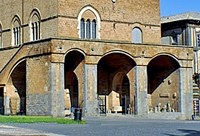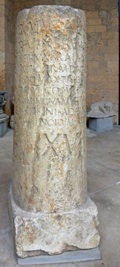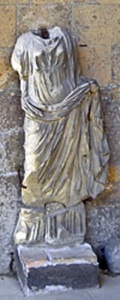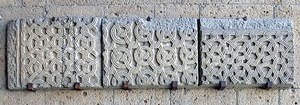


The loggia in front of the lower room of Palazzo Soliano contains a number of interesting Roman remains found in the surrounding area.
Inscribed Milestone (107 AD)

Imp(erator) Caesar / Divi Nervae f(ilius)
Nerva Traianus / Aug(ustus) Germ(anicus) Dacicus
pont(ifex) max(imus), trib(unicia) pot(estate) XII
[i]mp(erator) VI, co(n)s(ul) V, p(ater) p(atriae)
Viam Novam [Tra]ia[n(i)]
a Volsinis ad fines / Clusinorum fecit/ XVII
This inscription is described in the page on Roman Volsinii (Bolsena).
Funerary Cippus (ca. 100 AD)
This inscription (CIL XI 2706) was discovered in 1881 during excavations in Piazza Grande, of Castel Viscardo. It reads:
D(is) M(anibus) / Ulpiae Terpsidi
Securus Aug(usti) disp(ensator)
coniugi / bene /merenti
et Hilarus fil(ius)
matri / pientissimae
It commemorates a freed slave, Ulpiae Terpsidi, the well-deserving wife of Securus (who was probably still a slave) and pious mother of Hilarus. Securus (who was still a slave)held the post of imperial dispensator (treasurer), probably of the Emperor Trajan. This inscription is described in the page on Roman Volsinii (Bolsena), in the context of the evidence for an imperial estate near that city.
Venus of Pagliano (ca. 100 AD)

Emperor Constantius I (ca. 306 AD)
An inscription (CIL XI 2697, EDR126862) on the base of a statue, which presumably came from Roman Volsinii (Bolsena), commemorated the Emperor Constantius I:
Imp(eratori) Caes(ari) / Flavio Cons/tantio Pio / Fel(ici) Invicto / Aug(usto) [...]
To the Emperor Caesar Flavius Constantius, pious, fortunate, unconquered Augustus ...
Paleochristian Reliefs (perhaps 9th century)

These reliefs probably came from Sant’ Andrea.

